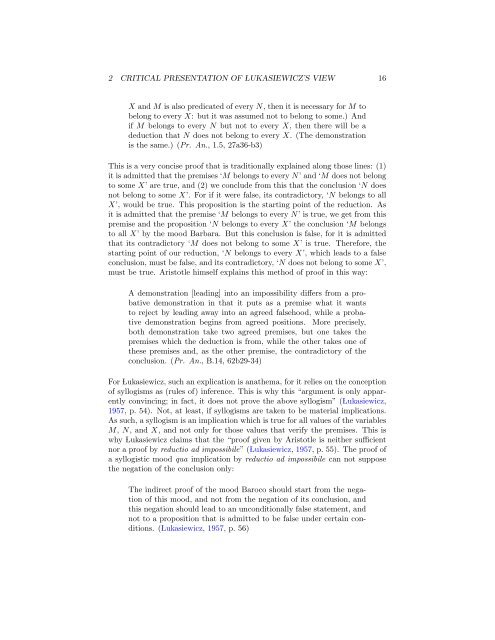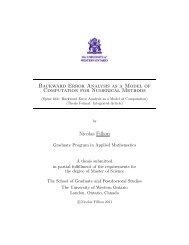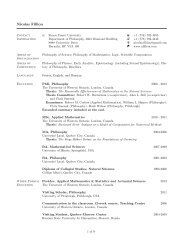Two Accounts of Aristotle's Logic - Nicolas Fillion
Two Accounts of Aristotle's Logic - Nicolas Fillion
Two Accounts of Aristotle's Logic - Nicolas Fillion
You also want an ePaper? Increase the reach of your titles
YUMPU automatically turns print PDFs into web optimized ePapers that Google loves.
2 CRITICAL PRESENTATION OF ̷LUKASIEWICZ’S VIEW 16<br />
X and M is also predicated <strong>of</strong> every N, then it is necessary for M to<br />
belong to every X: but it was assumed not to belong to some.) And<br />
if M belongs to every N but not to every X, then there will be a<br />
deduction that N does not belong to every X. (The demonstration<br />
is the same.) (Pr. An., 1.5, 27a36-b3)<br />
This is a very concise pro<strong>of</strong> that is traditionally explained along those lines: (1)<br />
it is admitted that the premises ‘M belongs to every N’ and ‘M does not belong<br />
to some X’ are true, and (2) we conclude from this that the conclusion ‘N does<br />
not belong to some X’. For if it were false, its contradictory, ‘N belongs to all<br />
X’, would be true. This proposition is the starting point <strong>of</strong> the reduction. As<br />
it is admitted that the premise ‘M belongs to every N’ is true, we get from this<br />
premise and the proposition ‘N belongs to every X’ the conclusion ‘M belongs<br />
to all X’ by the mood Barbara. But this conclusion is false, for it is admitted<br />
that its contradictory ‘M does not belong to some X’ is true. Therefore, the<br />
starting point <strong>of</strong> our reduction, ‘N belongs to every X’, which leads to a false<br />
conclusion, must be false, and its contradictory, ‘N does not belong to some X’,<br />
must be true. Aristotle himself explains this method <strong>of</strong> pro<strong>of</strong> in this way:<br />
A demonstration [leading] into an impossibility differs from a probative<br />
demonstration in that it puts as a premise what it wants<br />
to reject by leading away into an agreed falsehood, while a probative<br />
demonstration begins from agreed positions. More precisely,<br />
both demonstration take two agreed premises, but one takes the<br />
premises which the deduction is from, while the other takes one <strong>of</strong><br />
these premises and, as the other premise, the contradictory <strong>of</strong> the<br />
conclusion. (Pr. An., B.14, 62b29-34)<br />
For ̷Lukasiewicz, such an explication is anathema, for it relies on the conception<br />
<strong>of</strong> syllogisms as (rules <strong>of</strong>) inference. This is why this “argument is only apparently<br />
convincing; in fact, it does not prove the above syllogism” (̷Lukasiewicz,<br />
1957, p. 54). Not, at least, if syllogisms are taken to be material implications.<br />
As such, a syllogism is an implication which is true for all values <strong>of</strong> the variables<br />
M, N, and X, and not only for those values that verify the premises. This is<br />
why ̷Lukasiewicz claims that the “pro<strong>of</strong> given by Aristotle is neither sufficient<br />
nor a pro<strong>of</strong> by reductio ad impossibile” (̷Lukasiewicz, 1957, p. 55). The pro<strong>of</strong> <strong>of</strong><br />
a syllogistic mood qua implication by reductio ad impossibile can not suppose<br />
the negation <strong>of</strong> the conclusion only:<br />
The indirect pro<strong>of</strong> <strong>of</strong> the mood Baroco should start from the negation<br />
<strong>of</strong> this mood, and not from the negation <strong>of</strong> its conclusion, and<br />
this negation should lead to an unconditionally false statement, and<br />
not to a proposition that is admitted to be false under certain conditions.<br />
(̷Lukasiewicz, 1957, p. 56)




